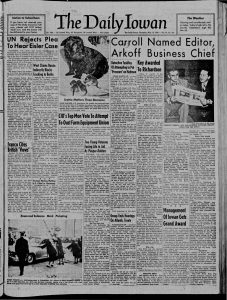The field of journalism has transformed wildly since Harold Arkoff graduated from college in 1950.
The World War II veteran attended the University of Iowa’s School of Journalism in the late-1940s and worked in advertising at The Daily Iowan, which at the time published a morning newspaper every day of the week except Monday.

In the 68 years since, Arkoff saw the media industry revolutionize with the advent of radio, television, and the Internet. Some rural homes did not even have electricity when he was young, he said.
“Even if you take 68 years from today, things are going to be different,” Arkoff said. “What’s going to happen then? Who knows. But you have to accept and embrace change.”
Throughout his career, Arkoff worked at various radio and television stations. He ended up in Calabasas, California, and was a part-owner of two radio stations in California: KGIL near Los Angeles and KKHI AM-FM in San Francisco.
Arkoff’s roots are in the Hawkeye State, though. Born in 1925 in Fort Dodge, Iowa, Arkoff spent two years in New Guinea fighting the Japanese in World War II. He returned home in 1946, enrolled in junior college, and “ate my mother’s cooking for a year.”
He moved on to the UI in 1947, where he received a bachelor’s degree in journalism and a master’s in mass communication. In 1949, Arkoff served as the business manager at the DI, overseeing the publication’s advertising operations.
“We basically lived in the basement of East Hall,” he said.
East Hall, now known as Seashore Hall, was home to the completely student-run DI newsroom. The building at the intersection of Iowa and Linn Streets is undergoing demolition to make way for a new psychology building.
RELATED: Partial demolition of Seashore Hall taking place this winter
Arkoff and Editor Charles Carroll worked together each day to decide the layout of the paper — the number of pages, the location of ads, and the positioning of stories.
When Arkoff and the staff weren’t in the newsroom, he remembered, they could be found at Joe’s Place on Iowa Avenue or the Airliner on Clinton Street. Sometimes, he recalled, the staff conducted the DI’s planning at these downtown spots.
Much of the paper’s coverage he remembers from that time focused on veterans coming home. Because of the war, he said, college students were a few years older than they are today — Arkoff was 24 when he received his bachelor’s degree.
One story he fondly remembers the DI covering was a baby race in the Field House. Because many students were older, a lot of them were married with children.

“You entered your baby in this race, and the babies would crawl and see which one won,” he said. “It was a lot of fun.”
Arkoff’s roommate in college happened to be Sam Becker, the eponym of the Becker Communications Building. The late Becker, who was nicknamed “Mr. University of Iowa,” served in numerous faculty and administrative positions during the 70 years he was affiliated with the UI.
Becker and Arkoff lived together on East Bloomington Street. The two both served in the Army during World War II.
“We both found out that we were fighting the Japanese on this same island at the same time. It was a coincidence,” Arkoff said.
Becker’s area of study was in communications, while Arkoff’s was in journalism advertising. Unlike today, the UI School of Journalism offered a track in advertising as part of the curriculum, along with tracks in editorial writing, photography, community newspaper, and radio journalism.
Nowadays, the news production at the DI continues to be student-run, but a professional staff handles the business and advertising operations. The Journalism School also offers no track in advertising. Arkoff thinks it’s a shame journalism students today no longer have that option.
“I think that if I was the head of the Journalism School at the University of Iowa now, I would put in an advertising program like we had, but I would cater it toward Google and technology,” Arkoff said. “I think the main difference is that when I was in school there, you could tell advertising was advertising and editorial was editorial, but now, there’s been a blending of marketing.”
Despite all that has changed in the world of journalism in the last 68 years, Arkoff still reads a newspaper every day — sometimes two.
“A lot of that has gone into iPads, and iPhones, and technology,” he said. “I personally think that too much of that is automated now, and I think people who don’t read a daily newspaper are missing an awful lot.”



